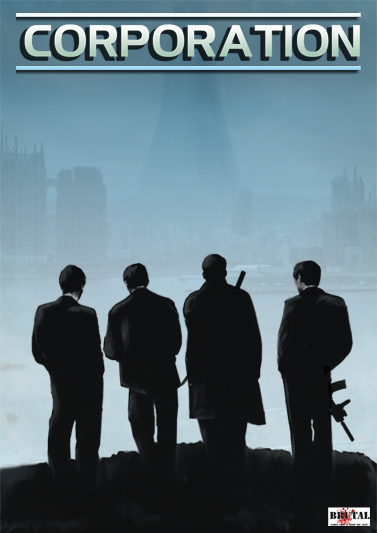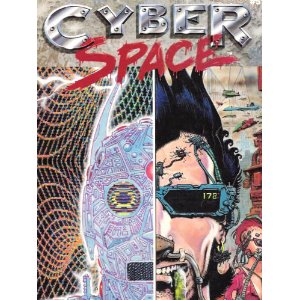Please include your name in the transaction description if using this to pay your membership.
Blogs
Jonathan Tweet Interview
Thu, 04/07/2011 - 10:56 — rpgrevJonathan Tweet is a significant figure in the game design industry. With the first publication as co-author with Mark Rein*Hagen for the award-winning Ars Magica in 1987, Tweet is also the designer of the surreal Over The Edge (1992) and Everway (1995), two rules-simple narrative-heavy games, the designer of Talislanta Guidebook (3rd edition) also in 1992, and most notably the core rule books for third edition of Dungeons & Dragons. With more than twenty-five other supplements and scenarios there can be no doubt that an indelible mark has been left by Tweet on the industry.
- rpgrev's blog
- Login to post comments
- Read more
The Future Is Near... A Thematic Review of Near Future RPGS
Wed, 01/05/2011 - 10:44 — rpgrevThe famous Yugoslav academic of science fiction literature, Darko Suvin, once referred to science fiction as the mythology of modernity framed within a scientific cognitive framework. It is the mythological aspect that is explored here, the idea that 'near future' roleplaying games reflect the hopes, dreams, fears and speculations of the authors, whether consciously or not. The scientific cognitive requirement in this context is less important than what Suvin would desire in defining a science fiction game, requiring a solidly materialist outlook.
- rpgrev's blog
- Login to post comments
- Read more
The Riddle of Steel Review
Tue, 12/28/2010 - 00:28 — rpgrevIt came with great promise, it generated polarised debate around 2001 to 2003, it has now almost entirely disappeared, the website gone, the book out-of-print and rarely seen in second-hand sources. It is The Riddle of Steel, and when I managed to pick up a copy recently, I could not help but give it a few sessions to find out what all the fuss was about.

The Physical Product
The 270 page hardback is well bound and comes with an attractive fish-eye lens graphic of a warrior holding aloft an implausible sword. The interior art is often below average in terms of technique and well-below average in terms of creativity, although the inclusion of reprints from renaissance era manuscripts is an exception, as is the amusing female lancer on the back of the giant lizard. Nearly all of the art is placed with little regard to context either, with some exceptions (e.g., encumbrance).
The book is formatted with a two-column justified layout and a serif-font. The margins have chapter and section headings (top and side, respectively), which is pleasing. There is a good two-page table of contents and four-page index, although the formatting of the latter is a little askew. The product is broken into eight "books", each containing several chapters and some of those with sub-chapters.
The writing style is accessible and efficient with a direct statement of rules, elaboration and/or explanation and examples, although with the occasional spelling error and lapse into silliness. Each 'book' is unfortunately introduced with a short narrative with does nothing for the understanding of the game or the setting; compare with The Travels of Biturian Varosh.
- rpgrev's blog
- Login to post comments
- Read more
Corporation Review
Tue, 12/28/2010 - 00:22 — rpgrev
The Product
Corporation is released by Mongoose Games, under their Flaming Cobra of independents, in this case, Brutal Games. It's a beautifully bound hardback, absolutely rock solid in production qualities and lies quite flat when opened. The 256 page text is two column justified, sans-serif (not a good look for print, great for online), with boxed page numbers and chapter titles in the modest margins, top right and top left respectively. This is supplemented by boxed italic text providing short, descriptive narratives, and sectioned text to highlight specific rules. The cover is simple but evocative, a group of four Agents (think covert ops, men in black etc) overlooking a misty river with a spire and an old city in the background. The internal art is competent and evocative, presenting the cyberpunk and special agent setting which is central to the game. Unfortunately the printing is far too dark and much of the detail of the internal artwork has been lost in production. I've been told the clarity of the artwork is superior in the full-colour PDF version of the game.
The book is broken up into thirteen chapters, made explicit by a very clear two-page table of contents, with a three page index supplementing. After a brief introduction the game dives right into Character Generation followed by four chapters assisting the process (Equipment, Cybernetics, Telepathics, Character Advancement), and two chapters of central setting information for characters (The Corporations, the UIG and the Order of the Truth Faith). It is well into the book (chapter 8, p137) until the actual game system is explained, and this brief chapter (13 pages) is followed by supplementary setting information for the next three (The World in 2500, The Cities, People and Places). The last two chapters are GM aids, including sample scenarios and sample NPCs (Running Corporation, Antagonists).
- rpgrev's blog
- Login to post comments
- Read more
Cyberspace Review
Tue, 12/28/2010 - 00:16 — rpgrevThere was a time in the late 1980s when there was quite a run on cyberpunk roleplaying games; Cyberpunk (1st edition and 20.20), and Shadowrun were, of course, the big names, and even Traveller 2300 (2300AD) decided to have a shot with the Earth/Cybertech supplement. From the ICE corner of the publishing market, came Cyberspace. It did strike as a little contrived and incongruous at the time. After all, ICE was known for their detail-heavy Rolemaster fantasy RPG, their Middle-Earth line, and a rather space operatic Spacemaster. Nevertheless, author Todd Foley (previously responsible for War on A Distant Moon and Beyond The Core for Spacemaster) stepped up to the task, with a stripped down version of the 'Master' system supplemented with cyberpunk setting and style.

Cyberspace came in a 206 page softcover with cover art from Rick Veitch, representing a juxtaposition of the crowded, polluted cybernetic environment and the abstract neon of cyberspace. It shows some creativity, but the technique is very much comic-book style, which is the illustrator's area of work. The interior art, by Rick Lowry, Angela Bostick, Del Harris, and Karl Martin, is nearly all good, giving a good sense of the style of cyberpunk with some images reminiscent of scenes from books and films of the time. The text is mostly presented in three-column ragged-right with an somewhat annoying sans-serif font, made up however by very clear and common sub-section headings along with obvious chapters heading and numbers on each page. Despite the density of the text finding the relevant material during play was as easily acquired skill.
After a short preface there are six chapters, The System, Running The World, Technology, Cyberspace, an Adventure and some very handy Appendices. These are supplemented by a good two-page table of contents and a somewhat short one page index. The writing style in the rules is mostly formal, to the point but supplemented with plenty of examples. There are thankfully short narratives introducing each chapter along with interesting occasional box-sections outlining annual events up to the year 2090, when the game is set.
- rpgrev's blog
- Login to post comments
- Read more
The History and Resurrection of RuneQuest!
Sat, 12/30/2006 - 13:00 — rpgrevTo be published in Phantasmagoria 2006: The Annual of Murdoch Alternative Reality Society
- rpgrev's blog
- Login to post comments
- Read more
Review of Traci Harding's Gene of Isis
Tue, 05/30/2006 - 14:00 — rpgrevVoyager, 2005, 468pp
- rpgrev's blog
- Login to post comments
- Read more
George R.R. Martin, A Feast For Crows
Thu, 03/30/2006 - 13:00 — rpgrevPublished in Ticonderoga
- rpgrev's blog
- Login to post comments
- Read more
Role Playing and Religion
Sat, 08/20/2005 - 14:00 — rpgrevRole Playing at the Melbourne Unitarian Church
- rpgrev's blog
- Login to post comments
- Read more
Historical Fantasy Campaigns for Role Playing Simulations
Mon, 12/22/2003 - 13:00 — rpgrevPublished in "Phantasmagoria" Murdoch Alternative Reality Society Annual, 2004, pp32-38
Why Historical Fantasy?
This article starts with an aesthetic opposition to modern fantasy.
- rpgrev's blog
- Login to post comments
- Read more
